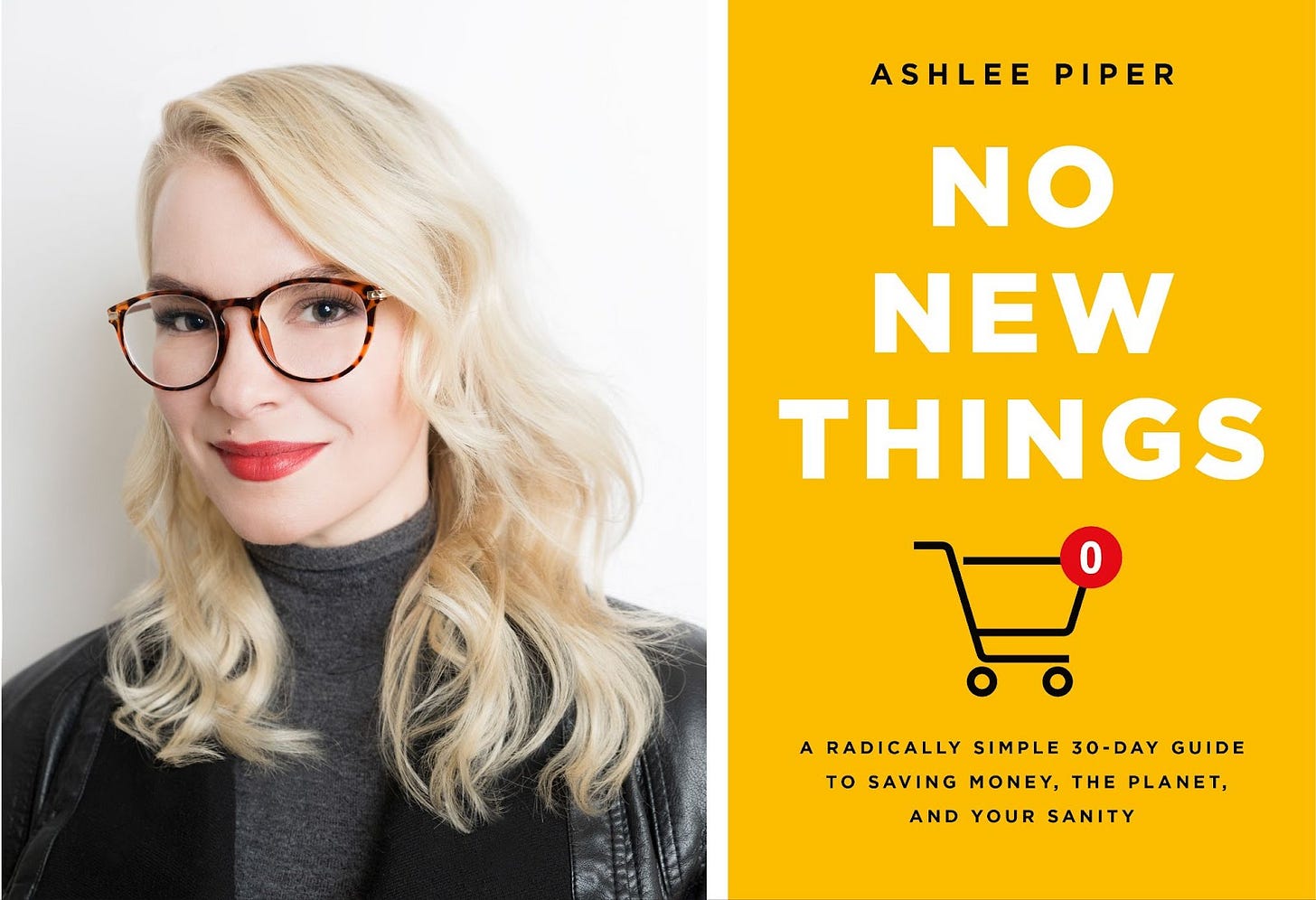A home makeover without buying anything new?
Ashlee Piper’s book can help you learn to love your home again
No new things. These three words were the name Ashlee Piper gave her personal challenge to shop only secondhand back in 2013. She ended up spending a year and a half not buying anything new. These three words became a wildly popular social media challenge #nonewthings and are now the title of Ashlee’s new book No New Things: A Radically Simple 30-Day Guide to Saving Money, the Planet, and Your Sanity.
A public speaker and educator in the realm of sustainability, Ashlee has been an expert for several stories I’ve written. Over the years I have also come to think of her as a far-flung friend. A couple of weeks ago, we sat down to talk about her new book and how it relates to our homes.

For the last decade, Ashlee’s been sharing the #NoNewThings challenge on social media, encouraging others to join her in a month-long challenge to not buy anything new. Anyone could go off and do #NoNewThings tomorrow without further instructions, but there’s a particular magic in Ashlee’s method and how she presents it in the book.
It’s not just about not buying new things (something I’ve talked about a lot in this newsletter lately). This book is about what you do instead—and how that can shift your habits and your mindset.
Ashlee prescribes a regime of care and repair for our homes not just because it will improve them, but because she believes it will change how we feel about them (especially those of us living in small spaces). “When we realize how much we actually have by taking care of our stuff, we can shake off the marketing narrative of never having enough that drives us to over consume,” she says.
Here are five ways to apply a #nonewthings mindset to your home.
Tackle that to-donate bag
I felt like Ashlee had a spy cam in my apartment when she said, “I know enough about people to know that you probably already have bags of things you’ve already vowed to donate or take to the special recycling center, animal shelter, or Little Free Library.” (Guilty as charged.) Get the stuff that you already know you want to get rid of out first to create space. Then work on thinning out more after the low-hanging fruit is tackled.
Give one thing some real love
Find something in your home that needs some tender loving care—a couch that needs a good once over with a depiller, a wobbly table that needs its bolts tightened and a fresh coat of furniture wax—and fix it. “You are the steward of your stuff,” Ashlee says, adding, “Not only does this sprucing extend an item’s usefulness and keep the landfill at bay, it also imparts that feeling of freshness we’re often seeking when we buy new items for our homes.”
Schedule a power hour
Ashlee suggests setting a timer for one hour and going through your home to fix and maintain tiny things that you never get around to. Tighten the screw on the toilet paper holder that’s falling down, scrub the smudges off your walls with a magic eraser, and actually hang that framed art you bought months ago. You may be surprised how much you can get done in a dedicated hour. Rinse and repeat and you’ll start to see real improvements.
Rearrange a space
I’ve often suggested that people should try rearranging their stuff instead of buying something new, but Ashlee revealed to me that there’s actual science behind this idea. “Our brains are remarkable pattern-making machines that can become accustomed to our spaces,” she says. “Shifting or changing elements of an area stimulates our brain to find new focal points, thereby stoking and enhancing concentration.” A new perspective on a room can give you that hit of delight you might normally get from buying something new.
Embrace second hand
If you decide you really do need something for your home, it’s no surprise that Ashlee and I would both tell you to try to buy it secondhand first. But if you associate previously-loved items with being lesser or even unclean, Ashlee has a smart way to reframe your thinking. “We equate the experience of staying in a hotel or a vacation home with luxury. You use towels, sleep in the bed, and sit on the furniture that many, many people have used before you—yet people will get skeeved out by a secondhand shirt or chair,” she points out. “How you feel about something that has been used is just a matter of a mindset shift.”
Track how you feel
If you feel motivated to buy something for your home, write it down and take note of what’s behind the impulse. “I encourage people to write down their triggers, to track how they're feeling in those moments,” says Ashlee. “There are patterns, and when people have been tracking, they see them pretty quickly.” Knowing when you got the impulse to buy something, where you saw it, how much it cost, how you were feeling in that moment—all of that is important data that will help you to better understand your relationship to consumerism. (I took notes back when I first stopped shopping on Amazon and found this process super-helpful.)
For more tips on how to change your relationship to your stuff, I recommend picking up a copy of No New Things wherever books are sold, including Bookshop.org and Barnes & Noble. I’m also giving away a copy to one paid subscriber. To enter to win the book, simply leave a comment below.
I also encourage you to follow Ashlee on Instagram @ashleepiper and sign up for her newsletter The Ethical Edit.
3 More Things
The best small space I saw last week was a Greenwich Village studio apartment that took me back to my first years in New York City, written up by the inimitable Wendy Goodman for New York magazine.
Me elsewhere: I was profiled by
in his Shelter newsletter (and he gave my story the best headline). Seth asked me a series of questions à la the Proust Questionnaire that were fun to answer. You can read it here.Shopping: Have you seen IKEA’s latest Stockholm collection? I haven’t seen it in person, but from what I see online it’s really good. The Stockholm collections are slightly higher quality (and price) than the regular IKEA fare. Especially into this grey birch rug.
One last thing: A British daydream.









I've started to think of secondhand goods as "battle-tested." If this secondhand dresser is still stably on four legs after a lifetime in someone else's home, or this water pitcher survived decades of use in another's kitchen, then it's that much more likely to make it in my home full of small children.
This is fun to think about! No new things could feel like a prison…and instead it’s a fun way to work with what you have!